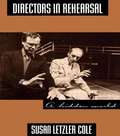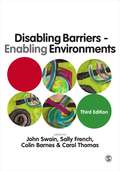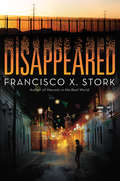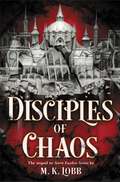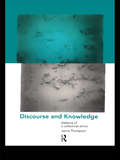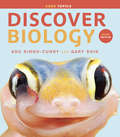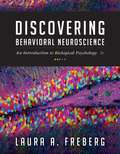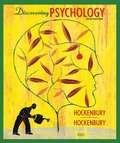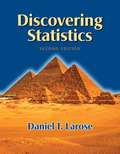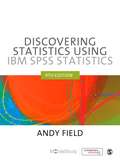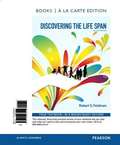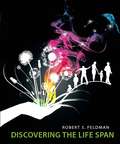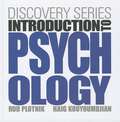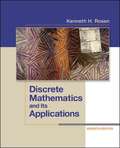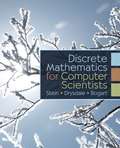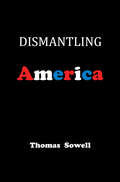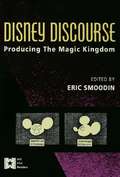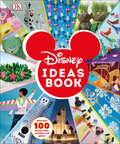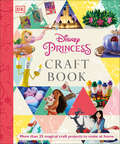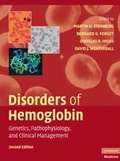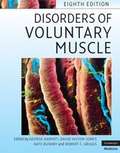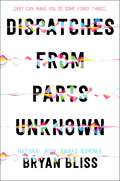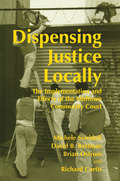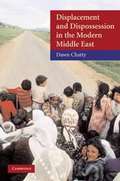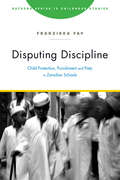- Table View
- List View
Directors in Rehearsal: A Hidden World
by Susan Letzler ColeSusan Cole's firsthand, moment-by-moment account of the rehearsal sessions of acclaimed directors and actors offers a view of what is often hidden from the public eye: what actors and directors do when they prepare a dramatic text for performance. Directors in Rehearsal is based on hundreds of hours observing and recording the directorial work process of such prominent directors as Robert Wilson, Peter Sellars, and JoAnne Akalaitis working with well-known actors and actresses, including Kevin Kline, Amanda Plummer, and David Warrilow, on texts ranging from Shakespeare and Chekhov to the Wooster Group's recent experiments. The result of her extensive research is a rare behind-the-scenes look at ten theatre directors, five women and five men, rehearsing actual productions--Broadway and off-Broadway, political and experimental, text-centered and company-created. An epilogue compares the rehearsal process in professional and college theatre. Directors in Rehearsal will be of interest to directors and actors, drama teachers and students, critics and theatre historians, practitioners and audiences.
Disabling Barriers, Enabling Environments (Third Edition)
by Carol Thomas John Swain Sally French Colin Barnes`The strengths of this text are many. It has breadth and diversity in its content yet is presented in bite-size chapters. For those wishing to know more, it offers signposts to the relevant literature. The contributors have been carefully selected for their specific perspective yet these have been skilfully inter-related by the editors. It is now some 11 years since the first edition of this text was published. In my view, this second edition was worth the wait' - SCOLAG Journal `This has been a ground-breaking book...and I whole-heartedly welcome a new edition'- Professor Len Barton, School of Education, The University of Sheffield `It is a really well-structured book which has been very popular and widely used by students...Its great qualities are accessibility and diversity of contributors' - Jenny Corbett, Institute of Education, University of London `This book would be a valuable resource to students of disability studies and to health and social care staff and other professionals who work with disabled people'- Disability and Rehabilitation The Second Edition of this landmark text has been revised to provide an up-to-date accessible introductory text to the field of disability studies. In addition to analysing the barriers that disabled people encounter in education, housing, leisure and employment, the revised edition has new chapters on: · international issues · diversity among disabled people · sexuality · bioethics. Written by disabled people who are leading academics in the field, the text comprises 45 short and engaging chapters, to provide a broad-ranging and accessible introduction to disability issues. Disabling Barriers, Enabling Environments is an invaluable resource for both students and practitioners alike. It is an ideal text for undergraduates and postgraduates taking courses in disability studies, as well as disability courses in social work, education, health studies, sociology and social policy.
Disappeared
by Francisco X. StorkYou've never seen a Francisco X. Stork novel like this before! A missing girl, a determined reporter, and a young man on the brink combine for a powerful story of suspense and survival.Four Months AgoSara Zapata's best friend disappeared, kidnapped by the web of criminals who terrorize Juarez.Four Hours AgoSara received a death threat -- and with it, a clue to the place where her friend is locked away.Four Weeks AgoEmiliano Zapata fell in love with Perla Rubi, who will never be his so long as he's poor.Four Minutes AgoEmiliano got the chance to make more money than he ever dreamed -- just by joining the web.In the next four days, Sara and Emiliano will each face impossible choices, between life and justice, friends and family, truth and love. But when the web closes in on Sara, only one path remains for the siblings: the way across the desert to the United States.
Disciples of Chaos
by M.K. LobbIn this thrilling sequel to Seven Faceless Saints, Roz and Damian must face their destiny as the world crumbles around them amidst a worsening war—perfect for fans of Leigh Bardugo and Kerri Maniscalco. Damian Venturi isn't aware of it yet, but as small shifts start to crack the foundations of the Ombrazian power structure after the Rebellion's attack, cracks are beginning to show in Damian's own facade. Uncontrollable anger is bubbling to the surface and can't always be pushed down. Can he keep everyone safe, even from himself? Rossana Lacertosa should feel victorious. She accomplished everything she set out to do, and more. The Rebellion's attack set countless prisoners free and brought attention to the unfairness in the Palazzo's structure. And Damian is back by her side where he belongs. Yet the war with Brechaat rages on and government officials are hellbent on keeping the status quo. Then an Ombrazian general arrives from the front lines, and orders dozens of arrests, shipping Roz and Damian's friends up north. Determined to free those who matter most, Roz and Damian set their sights on Brechaat. But their journey is dogged by strange magic, and Damian shifts further from the boy he used to be. The complications of love, magic, faith, and war will keep readers eagerly turning the pages as they head towards the gripping conclusion in the Seven Faceless Saints duology.
Discourse and Knowledge: Defence of a Collectivist Ethics
by Janna ThompsonEthical disagreement is a fact of social life. We disagree about issues such as abortion, euthanasia, the meaning of justice and the treatment of animals, and our debates often fail to reach a consensus. Some philosophers think that this means there is no objective knowledge about morality. Discourse and Knowledge takes a radically different approach to the defence of ethical rationality. It claims that there is a correct solution to ethical controversies, but that ethical decisions have to be made collectively. Written specifically for those studying or teaching ethics or moral theory,Discourse and Knowledge will also be ideal for those on courses on social theory, ethics or feminist philosophy.
Discover Biology (Sixth Edition)
by Anu Singh-Cundy Gary ShinDiscover Biology facilitates the active learning of science in and out of class. It advocates for "Scientific literacy through active learning. before, in and after class." ,,, for this to be achieved, students must retain the core concepts learnt in class.
Discovering Behavioral Neuroscience: An Introduction to Biological Psycology,3rd Edition
by Laura A. FrebergDISCOVERING BEHAVIORAL NEUROSCIENCE: AN INTRODUCTION TO BIOLOGICAL PSYCHOLOGY, 3rd Edition is written to appeal to a broad range of readers interested in a college-level introduction to biological or physiological psychology. Whether readers have a strong science background or are novices who feel intimidated at the prospect of the subject matter, this book's clear writing, high-interest examples, learning aids, and numerous illustrations will keep them interested and engaged. The book includes classic concepts, current topics, and cutting-edge research to provide readers with a foundational understanding of the structure and function of the nervous system and its relationship to both typical and disordered human behavior.
Discovering Psychology (5th Edition)
by Don H. Hockenbury Sandra E. HockenburyUses engaging anecdotes and stories to make abstract material pertinent without over-simplifying the science. The fifth edition features new coverage of developments in the study of positive psychology, Asperger's syndrome, sleep, consciousness and sex differences in the brain, as well as new artwork, chapter summaries and revised appendices.
Discovering Statistics (2nd Edition)
by Daniel T. LaroseDiscovering Statistics is intended for an algebra-based, undergraduate, one- or two-semester course in general introductory statistics for non-majors. It will prepare you to work with data in fields such as psychology, business, nursing, education, and liberal arts, to name a few.
Discovering Statistics using IBM SPSS Statistics
by Andy FieldUnrivalled in the way it makes the teaching of statistics compelling and accessible to even the most anxious of students, the only statistics textbook you and your students will ever need just got better!<P><P> Andy Field's bestselling Discovering Statistics Using SPSS 4th Edition, already an immensely comprehensive textbook - taking students from first principles to advanced statistical concepts, and all the while grounding knowledge through the use of SPSS - now focuses on providing essential updates, better accessibility to its key features, more instructor resources and broader reach to new student groups - with powerful new digital developments on the textbook's companion website.<P> New to the 4th Edition<P> - New WebAssign® facility. If you adopt this for use on your course it will allow you to produce and manage assignments online with your students and includes a grading facility to monitor students' progress. Students can practise questions over and over and be provided with instant feedback and links to the accompanying Ebook where correct solutions can be found<P> - The mobile study facility encourages students equipped with smartphones and tablets to access revision material such as Cramming Sam's Study tips helping them to study when it suits them. QR codes in the textbook provide instant access<P> - Education and Sport Sciences instructor support materials with enhanced ones for Psychology, Business and Management and the Health sciences make the book even more relevant to a wider range of subjects across the social sciences and where statistics is taught to a cross-disciplinary audience.<P> Major Updates to the 4th Edition<P> - Fully compatible with recent SPSS releases up to and including version 21<P> - Exciting new characters. Statistical cult leader Oditi provides students with access to video clips to help further understanding of statistical/SPSS concepts, while Confusious helps students to make better sense of statistical terms<P> - An enhanced Companion Website offers plenty of lecturer and student material to use in conjunction with the textbook. These include PowerPoints and Testbanks for lecturers as well as answers to the Smart Alex tasks at the end of the each chapter; datafiles for testing problems in SPSS; flashcards of key concepts; self-assessment multiple-choice questions; and online videos of key statistical and SPSS procedures discussed in the textbook for students.
Discovering The Life Span (Second Edition)
by Robert S. FeldmanModular, Manageable, Meaningful- help your students discover the life span! Discovering the Life Span provides students with a strong balance of research and applications. Many instructors would like to cover the entire life span in a single term and help their students see the big picture. They want students to understand how the domains of development work together and perhaps, most importantly, have their students truly connect to the material. This remarkable text does all of this. Its balanced modular format treats each stage of life and each domain equally throughout the text. With 10 chapters, 3 modules per chapter, and only 576 pages, Discovering the Life Span is more manageable for instructors and students. It allows instructors to cover all areas of the life span without having to sacrifice content during their one-term course and students get a better sense of the entire process of development.
Discovering the Life Span
by Robert S. FeldmanModular, manageable, meaningful--help your students discover the life span! Based on extensive market research, and informed by author Robert Feldman's own teaching experience, Discovering the Life Span was created to meet key teaching needs. Many instructors would like to cover the entire life span in a single term. They would like their students to see the big picture and understand how the domains of development work together. And, perhaps most importantly, they would like their students to truly connect to the material. This remarkable first edition does all three of these things. Here's how: Structured around a modular format, each stage of life and each domain are treated equally throughout the text. This balanced format offers instructors teaching flexibility while helping students see the connections between the physical, cognitive, and social/personality domains.
Discovery Series: Introduction to Psychology
by Rod Plotnik Haig KouyoumdjianThe Cengage Learning DISCOVERY SERIES: INTRODUCTION TO PSYCHOLOGY is designed to deliver traditional course content in an innovative "hybrid" learning format--instruction presented in a printed book paired with integrated online applications and assessments. The program promotes measurable mastery of core course learning objectives by guiding students' active engagement with content delivered through the book, images, video, simulations, and assessments. This contemporary approach to learning seamlessly integrates text and technology, enabling students to easily move from the book's instruction to its online applications for a deeper, lasting understanding of the core psychological concepts, and for assessments that reliably track students' progress and performance.
Discrete Mathematics and Its Applications Seventh Edition
by Kenneth H. RosenDiscrete Mathematics and Its Applications, Seventh Edition, is intended for one or two term introductory Discrete Mathematics courses taken by students from a wide variety of majors, including Computer Science, Mathematics, and Engineering.
Discrete Mathematics for Computer Scientists
by Clifford Stein Robert L. Drysdale Kenneth BogartDiscrete Mathematics for Computer Scientists provides computer science students the foundation they need in discrete mathematics. It gives thorough coverage to topics that have great importance to computer scientists and provides a motivating computer science example for each math topic.
Dismantling America: and other controversial essays
by Thomas SowellThese wide-ranging essays--on many individual political, economic, cultural and legal issues--have as a recurring, underlying theme the decline of the values and institutions that have sustained and advanced American society for more than two centuries. This decline has been more than an erosion. It has, in many cases, been a deliberate dismantling of American values and institutions by people convinced that their superior wisdom and virtue must over-ride both the traditions of the country and the will of the people. Whether these essays (originally published as syndicated newspaper columns) are individually about financial bailouts, illegal immigrants, gay marriage, national security, or the Duke University rape case, the underlying concern is about what these very different kinds of things say about the general direction of American society. This larger and longer-lasting question is whether the particular issues discussed reflect a degeneration or dismantling of the America that we once knew and expected to pass on to our children and grandchildren. There are people determined that this country's values, history, laws, traditions and role in the world are fundamentally wrong and must be changed. Such people will not stop dismantling America unless they get stopped--and the next election may be the last time to stop them, before they take the country beyond the point of no return.
Disney Discourse: Producing the Magic Kingdom (AFI Film Readers)
by Eric SmoodinHirohito and his Mickey Mouse watch, Goofy and Donald as our "Goodwill Ambassadors:" Disney Discourse is an interdisciplinary examination of the founder and his empire. These essays use an interdisciplinary approach to read through Disney's domestic cultural production "innocent" national icons, as well as theme parks, cartoons and television to analyze the global impact of American popular culture, the politics of Disney, and the complex reception Disney productions have received around the world.The Disney corporation's ever-increasing visibility the opening of Euro Disney and new stores in malls and vast influence over global culture demands critical attention not only in film and television studies, but in international diplomacy, architecture, economics and other related fields. Disney Discourse consolidates the best of the current work on Disney and provides a representative sample of past analyses of the Disney empire.Contributors: Julianne Burton-Carvajal, Lisa Cartwright, Brian Goldfarb, Richard deCordova, Douglas Gomery, David Kunzle, Jon Lewis, Moya Luckett, Richard Neupert, Susan Ohmer, José Piedra, Mitsuhiro Yoshimoto, Alexander Wilson.
Disney Ideas Book: More than 100 Disney Crafts, Activities, and Games
by DK Elizabeth DowsettBring your love of Disney to life with more than 100 amazing and creative projects and activities.The perfect rainy-day gift for kids who love Disney and enjoy crafting. Let their imaginations run wild with more than 100 enchanting Disney inspired arts and crafts, party games, puzzles, papercraft and many more fun and practical activities. With stunning photography and clear step-by-step instructions, the Disney Ideas Book guides you through each exciting project, from growing grass hair on Frozen trolls and creating The Lion King animal masks to crafting festive Mickey Mouse hanging decorations and Winnie the Pooh party hats. There are top tips on every page to help make your creations a success, with handy templates provided at the back of the book. Featuring family favourite characters from animation and live-action movies and TV, including Frozen, Toy Story, Moana, Inside Out and Cinderella.
Disney Princess Craft Book
by Elizabeth DowsettCreate your own Disney magic! Delve into the spellbinding world of Disney Princess and make your own magical crafts. Dress up in Moana's flower crown. Create Cinderella's pumpkin coach. Put on a shadow puppet show with Mushu. Pretend to be a Disney Princess with selfie props – and much more. With more than 25 projects accompanied by clear illustrated step-by-step instructions and top tips from expert crafters, there are ideas to suit every budding prince or princess!
Disorders of Hemoglobin: Genetics, Pathophysiology, and Clinical Management
by Martin H. Steinberg Bernard G. Forget Douglas R. Higgs David J. WeatherallThis book is a completely revised new edition of the definitive reference on disorders of hemoglobin. Authored by world-renowned experts, the book focuses on basic science aspects and clinical features of hemoglobinopathies, covering diagnosis, treatment, and future applications of current research. While the second edition continues to address the important molecular, cellular, and genetic components, coverage of clinical issues has been significantly expanded, and there is more practical emphasis on diagnosis and management throughout. The book opens with a review of the scientific underpinnings. Pathophysiology of common hemoglobin disorders is discussed next in an entirely new section devoted to vascular biology, the erythrocyte membrane, nitric oxide biology, and hemolysis. Four sections deal with α and β thalassemia, sickle cell disease, and related conditions, followed by special topics. The second edition concludes with current and developing approaches to treatment, incorporating new agents for iron chelation, methods to induce fetal hemoglobin production, novel treatment approaches, stem cell transplantation, and progress in gene therapy.
Disorders of Voluntary Muscle
by George Karpati David Hilton-Jones Kate Bushby Robert C. GriggsThis major new edition fulfils the need for a single-volume, up-to-date information resource on the etiology, pathogenesis, diagnosis and treatment of diseases of skeletal muscles, including the muscular dystrophies, mitochondrial myopathies, metabolic myopathies, ion channel disorders, and dysimmune myopathies. As background to the clinical coverage, relevant information on advances in molecular and developmental biology, immunopathology, mitochondrial biology, ion-channel dynamics, cell membrane and signal transduction science, and imaging technology is summarized. Combining essential new knowledge with the fundamentals of history-taking and clinical examination, this extensively illustrated book will continue to be the mainstay for practising physicians and biomedical scientists concerned with muscle disease. Regular updates on the clinical and basic science aspects of muscle disease - written mainly by rising stars of myology - will be published on an accompanying website.
Dispatches from Parts Unknown
by Bryan Bliss“The feel-good novel of the year.” —ALA Booklist (starred review)Julie knows it’s unusual that a professional wrestler runs a constant commentary on her life that only she can hear. But grief can be awfully funny sometimes. National Book Award nominee Bryan Bliss delivers a thought-provoking, one-of-a-kind novel about how to tread the line between moving on and holding on. Dispatches from Parts Unknown is for fans of David Arnold, Nina LaCour, and You’ve Reached Sam. Ever since her dad died three years ago, Julie has been surviving more than thriving. And surviving is sneaking into her parents’ closet when her mom is out, since it’s the only place that still sometimes smells like her dad. It’s roaming around the Mall of America. It’s pulling out the box of her dad’s VHS tapes, recordings of his favorite vintage professional wrestling matches.And it’s hearing the voice of the Masked Man in her head, running a commentary of her life.It’s embarrassing, really. Sure, he was her dad’s favorite wrestler, but that doesn’t mean she wants him in her head.As Julie finally starts to come out of the haze of grief, maybe she’ll finally figure out why that voice is there, and how to let it go.
Dispensing Justice Locally: The Implementation and Effects of the Midtown Cummunity Court
by Richard Curtis Brian Ostrom David Rottman Michele SviridoffThis book shows the significant impact and success that can be accomplished when courts are designed to meet the needs of the community regardless of traditional proceedings. The presentation of this unique approach marks the way for courts and ancillary justice agencies of all sizes to work together to build community confidence and assure not only quality of life but quality of justice.
Displacement and Dispossession in the Modern Middle East
by Dawn ChattyDispossession and forced migration in the Middle East remain even today significant elements of contemporary life in the region. Dawn Chatty's book traces the history of those who, as a reconstructed Middle East emerged at the beginning of the twentieth century, found themselves cut off from their homelands, refugees in a new world, with borders created out of the ashes of war and the fall of the Ottoman Empire. As an anthropologist, the author is particularly sensitive to individual experience and how these experiences have impacted on society as a whole from the political, social, and environmental perspectives. Through personal stories and interviews within different communities, she shows how some minorities, such as the Armenian and Circassian communities, have succeeded in integrating and creating new identities, whereas others, such as the Palestinians and the Kurds, have been left homeless within impermanent landscapes. The book is unusual in combining an ethnographic approach that analyzes the everyday experiences of refugees and migrants against the backdrop of the broad sweep of Mediterranean history. It is intended as an introduction for students in Middle East studies, history, political science, and anthropology and for anyone concerned with war and conflict in the region.
Disputing Discipline: Child Protection, Punishment, and Piety in Zanzibar Schools (Rutgers Series in Childhood Studies)
by Franziska FayDisputing Discipline explores how global and local children’s rights activists’ efforts within the school systems of Zanzibar to eradicate corporal punishment are changing the archipelago’s moral and political landscape. Through an equal consideration of child and adult perspectives, Fay explores what child protection means for Zanzibari children who have to negotiate their lives at the intersections of universalized and local "child protection" aspirations while growing up to be pious and responsible adults. Through a visual and participatory ethnographic approach that foregrounds young people’s voices through their poetry, photographs, and drawings, paired with in-depth Swahili language analysis, Fay shows how children’s views and experiences can transform our understanding of child protection. This book demonstrates that to improve interventions, policy makers and practitioners need to understand child protection beyond a policy sense of the term and respond to the reality of children’s lives to avoid unintentionally compromising, rather than improving, young people’s well-being.
